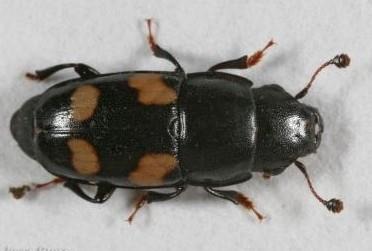Entomologists on campus have identified this sample as sap beetles (Carpophilus genus), a relatively common pest found in field corn, sweet corn, and other crops. The most common species to see around Iowa right now is fourspotted sap beetle. Most often, the beetles are secondary pests in corn, feeding on injured kernels at the tip. My general observation this summer was that sap beetle populations seemed very high in both sweet corn and field corn.
 Fourspotted sap beetle. Photo by Joyce Gross, UC Barkeley.
Fourspotted sap beetle. Photo by Joyce Gross, UC Barkeley.
While we also don’t typically think of these insects as stored grain pests, it is possible that they could infest stored products like stored grain in grain bins. In this farmer’s case, a small percentage of beetles survived after his low temperature (<110 F) drying operation and likely would still be present when the corn was moved to the grain bin for storage. Higher temperature drying operations are likely to kill beetles. As fall wears on, this farmer and others will want to monitor grain for the presence of these beetles, especially if grain will go directly from the field into a grain bin for storage.
Very little information seems to exist regarding management of sap beetles as a stored grain pest in corn. Edmond Bonjour, an Oklahoma State University extension entomologist and noted expert on pests of stored grain products, referred me to two documents available on the internet, a resource from Purdue on the biology of sap beetles and a resource from North Carolina State University that offers some practical management advice for sap beetles in field corn. The NC State publication notes that farmers can change combine settings to try and blow more of the beetles and broken kernels out of the combine but that insecticide treatment may be necessary before storing the grain in the bin.
We hope this was a one-off event for this particular farmer and that it will not be a more common issue this fall as corn harvest continues. Additionally, as temperatures cool, we hope sap beetles will move from corn ears to more protected areas to overwinter and eliminate concern for the pest making a home in any more stored corn grain. Please reach out if you think you’re seeing sap beetles in corn grain and would like help with identification or management.
Source : iastate.edu